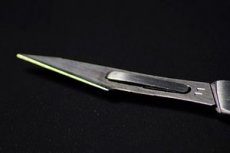Medical expert of the article
New publications
How to remove dry callus between toes?
Last reviewed: 06.07.2025

All iLive content is medically reviewed or fact checked to ensure as much factual accuracy as possible.
We have strict sourcing guidelines and only link to reputable media sites, academic research institutions and, whenever possible, medically peer reviewed studies. Note that the numbers in parentheses ([1], [2], etc.) are clickable links to these studies.
If you feel that any of our content is inaccurate, out-of-date, or otherwise questionable, please select it and press Ctrl + Enter.

Medicinal, folk and homeopathic treatment of dry calluses on the feet often require certain preparation, time and effort, and do not always give the expected results. But you really want to get rid of the uncomfortable growth as quickly as possible. And this opportunity is provided by surgical treatment, which goes hand in hand with physiotherapeutic methods.
True, doctors do not recommend resorting to such drastic measures unless absolutely necessary. Indications for hardware or surgical removal of dry calluses on the feet may be:
- Lack of positive dynamics in treatment with medications and folk remedies.
- Obstruction of performance of work duties.
- Serious problems with putting on shoes and moving around.
- The presence of diseases that may worsen due to a change in gait caused by pain syndrome and the inability to put weight on the entire foot.
- Old calluses that have gone deep into the soft tissues of the foot, making it impossible to remove them with external means.
- Development of painful core calluses against the background of a consistently reduced immunity, for example, with immunodeficiency (in this case, drug treatment may not give a quick result).
Direct surgical treatment, which is usually prescribed for the core type of callus, consists of drilling out the callus with a diamond cutter. The procedure is performed under local anesthesia (if desired, although it is not accompanied by pain) for 10-20 minutes. At the end of the treatment, the wound is covered with an aseptic bandage, and the patient can safely go home.
Another surgical treatment option is excision of the callus tissue with a scalpel. This operation is performed under general anesthesia. The patient then undergoes hospital treatment, receiving a scar on the foot as a reminder.
Physiotherapeutic treatment is considered less traumatic and practically bloodless, the options of which are:
Laser removal of dry calluses on feet
This method is considered the most popular and effective, as it virtually eliminates the risk of recurrence of the callus. The laser gently removes hardened tissue and the core of the callus, kills germs in the wound, coagulates damaged vessels, which helps avoid bleeding, and prevents inflammation during the recovery period. The laser beam dries out the keratinized tissue layer by layer, so the duration of the procedure will depend on the size of the callus.
There is almost no pain, but if desired, you can use oil anesthetics. The tissues recover quite quickly after the procedure, but it is still recommended to treat them with an antiseptic and protect them from friction with a plaster.
 [ 1 ]
[ 1 ]
Cryodestruction or freezing of calluses with liquid nitrogen
The cryotherapy device is used to treat the callus for half a minute, which leads to the destruction of its tissue. The patient does not feel any pain, only a slight tingling sensation.
The callus turns white and after some time falls off on its own. However, sometimes more than one procedure is required. The soft tissues of the foot are restored almost as quickly as after laser therapy.
Electrocoagulation and radio wave removal of dry calluses
These are methods of physical action that help destroy callus tissue using electric current and radiofrequency waves. These are bloodless and virtually painless methods, but they are used less often than cryodestruction and laser treatment.
Treatment with physical methods is carried out both in hospital conditions and in cosmetology rooms. It is very important to pay attention to the conditions in which the procedure is carried out in order to avoid the risk of infection.
After removing dry calluses on the feet using physical methods, the tissues recover faster than after surgical treatment (especially using a scalpel). But you will need to be careful for a couple of weeks, because physiotherapy can increase the sensitivity of the tissues to light. So keeping the lower part of the legs in the open sun is highly discouraged.

